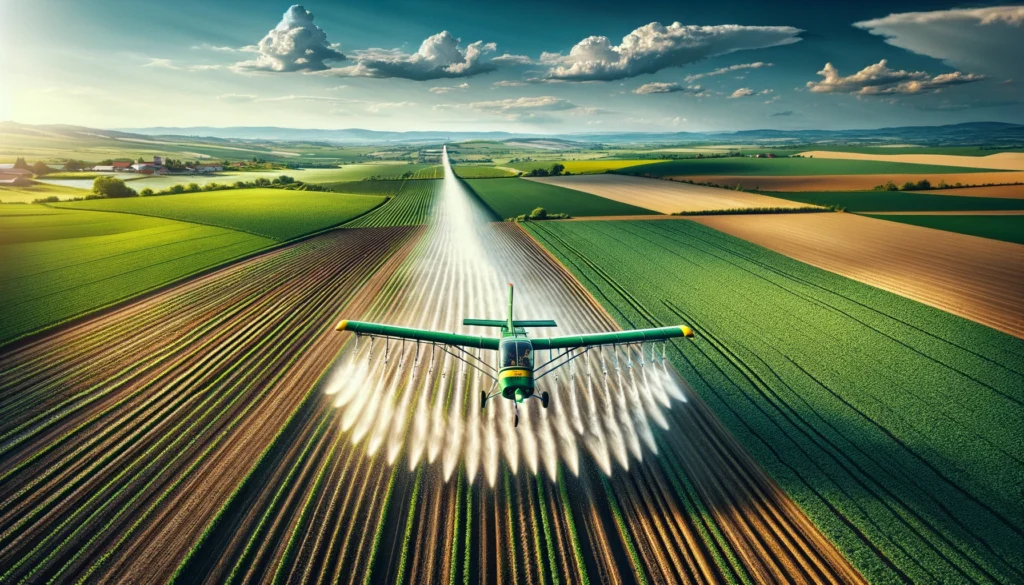
Farm Dictionary A vivid and detailed scene of aerial seeding. A small aircraft is flying low over a vast field releasing seeds onto the land below. The f1.webp.webp
Definition: Aerial Seeding
Aerial seeding is an agricultural technique that involves the distribution of seeds from the air using aircraft such as planes, helicopters, or drones. This method is used to plant crops, cover crops, or reforest large areas quickly and efficiently, especially in terrains that are difficult to access or after natural disasters. Aerial seeding is advantageous for its speed, coverage, and ability to reach remote or challenging locations.
Understanding Aerial Seeding
Introduction
Aerial seeding, also known as “broadcast seeding from the air,” is a method of sowing seeds over large areas using aircraft. This technique has been used in agriculture, forestry, and land restoration projects for decades, offering a practical solution for planting in difficult-to-reach or expansive terrains. The efficiency and effectiveness of aerial seeding make it an invaluable tool for modern farming and ecological restoration.
Fall off the barn roof and busted your keister? Life on the farm or ranch can be tough on the bum. Need a break? Laugh it off at FarmerCowboy.com, the #1 farm humor site. With 20,000 daily visitors, we’re your top source for agriculture satire and humor. Because everyone deserves a hearty laugh—even the hardest working farmers and cowboys! Join us and turn those long days into fun tales at FarmerCowboy.com.
Benefits of Aerial Seeding
- Speed and Efficiency: Aerial seeding allows for the rapid sowing of seeds over large areas, significantly reducing the time required compared to traditional ground seeding methods.
- Access to Difficult Terrain: It is particularly useful in areas that are hard to reach with conventional equipment, such as steep hillsides, wetlands, and post-disaster landscapes.
- Cost-Effective: While the initial cost of aerial seeding can be high, the overall cost is often lower than ground seeding due to the reduced labor and time required.
- Improved Soil Health: Aerial seeding of cover crops can enhance soil health by preventing erosion, improving soil structure, and increasing organic matter.
- Rapid Reforestation: It is an effective method for reforesting large areas, especially after wildfires or deforestation, helping to restore ecosystems quickly.
Applications of Aerial Seeding
1. Agriculture
In agriculture, aerial seeding is used to plant cover crops, main crops, and even for overseeding pastures. This method is particularly beneficial for large-scale farms where timely planting is crucial for maximizing yields.
Learn more about how aerial seeding is transforming modern farming in Aerial Seeding: The Sky is the Limit.
2. Forestry and Reforestation
Aerial seeding is extensively used in forestry for reforesting areas affected by logging, wildfires, or other disturbances. It helps in the rapid establishment of tree cover, which is essential for ecosystem recovery.
3. Land Restoration
This technique is also employed in land restoration projects to combat desertification, restore wetlands, and rehabilitate mining sites. Aerial seeding promotes the growth of native vegetation, which stabilizes soil and restores habitats.
For a comprehensive guide on implementing aerial seeding for land restoration, check out Aerial Seeding: A Farmer’s Guidebook.
Techniques and Equipment
- Aircraft Types: Different types of aircraft are used for aerial seeding, including fixed-wing planes, helicopters, and drones. The choice of aircraft depends on the size of the area to be seeded, the type of terrain, and the specific requirements of the project.
- Seed Dispersal Systems: Various seed dispersal systems are used, ranging from simple broadcast spreaders to advanced GPS-guided precision systems. These systems ensure even distribution and optimal seed-to-soil contact.
- Seed Preparation: Seeds may be coated with nutrients, pesticides, or other treatments to enhance germination rates and protect against pests and diseases. Seed mixtures are often tailored to the specific conditions of the site.
Challenges and Considerations
- Weather Conditions: Aerial seeding operations are highly dependent on weather conditions. Wind, rain, and temperature can affect seed dispersal and germination rates.
- Seed Viability: Ensuring the viability of seeds is crucial for successful germination. Proper storage, handling, and preparation of seeds are essential.
- Regulatory Compliance: Aerial seeding operations must comply with aviation regulations and environmental guidelines to ensure safety and minimal environmental impact.
Future Prospects
The future of aerial seeding looks promising with advancements in technology. The use of drones for precision seeding is becoming more widespread, offering greater control and efficiency. Innovations in seed technology and data analytics are also enhancing the effectiveness of aerial seeding, making it a valuable tool for sustainable agriculture and land management.
Conclusion
Aerial seeding is a powerful technique for large-scale planting, offering numerous benefits in terms of speed, efficiency, and access to difficult terrains. Its applications in agriculture, forestry, and land restoration make it an essential tool for modern land management practices. As technology advances, aerial seeding will continue to play a crucial role in enhancing agricultural productivity and environmental sustainability.
Originally posted 2024-05-27 04:06:59.
Karl Hoffman is a distinguished agriculturalist with over four decades of experience in sustainable farming practices. He holds a Ph.D. in Agronomy from Cornell University and has made significant contributions as a professor at Iowa State University. Hoffman’s groundbreaking research on integrated pest management and soil health has revolutionized modern agriculture. As a respected farm journalist, his column “Field Notes with Karl Hoffman” and his blog “The Modern Farmer” provide insightful, practical advice to a global audience. Hoffman’s work with the USDA and the United Nations FAO has enhanced food security worldwide. His awards include the USDA’s Distinguished Service Award and the World Food Prize, reflecting his profound impact on agriculture and sustainability.



